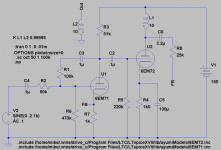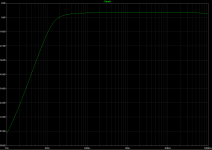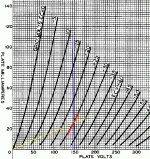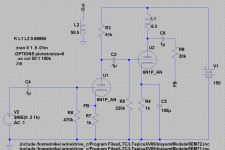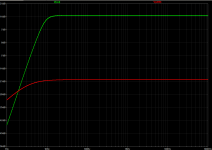An idea for an IT driver. I have been briefly looking at the problem of adequately driving an interstage transformer which would ease the requirements on the trannie's construction. Initially I was looking at driving it in the cathode of a follower stage but that did not look promising.
The power triode in the 6EM7 has very low Rp and the tube is not horribly expensive or hard to find. By using the included small signal triode as a VAS to feed the power triode we can add a bit of FB to further reduce the driving impedance.
Of course this doesn't allow the eliminating of all coupling caps and plate resistors but it would (if used to drive the output tube(s)) allow eliminating them at a particularly advantageous position.
Maybe???
The power triode in the 6EM7 has very low Rp and the tube is not horribly expensive or hard to find. By using the included small signal triode as a VAS to feed the power triode we can add a bit of FB to further reduce the driving impedance.
Of course this doesn't allow the eliminating of all coupling caps and plate resistors but it would (if used to drive the output tube(s)) allow eliminating them at a particularly advantageous position.
Maybe???
Attachments
Depends on what you want to achieve. For low frequency high performance you might need at least 40H @50mA DC to ensure low distortion already at 20H and very low from 30Hz and above.
On the other end you need a transformer that suits your 750R source impedance without peaking....
This should be nice:
Sowter type 9525
On the other end you need a transformer that suits your 750R source impedance without peaking....
This should be nice:
Sowter type 9525
Oops. R1 and R2 and the associated cap are leftovers from earlier circuit that I forgot to delete. :}
The idea of the power triode was to take advantage of the low Rp. FB was to get a bit more bang for the bottle. As drawn it pulls about 20mA. I could try biasing a bit cooler and see what the resulting higher Rp does. Could also try other lower current tube types but it is hard to find 1k or lower Rp under 20mA.
More investigation in order. I appreciate the input very much.
The idea of the power triode was to take advantage of the low Rp. FB was to get a bit more bang for the bottle. As drawn it pulls about 20mA. I could try biasing a bit cooler and see what the resulting higher Rp does. Could also try other lower current tube types but it is hard to find 1k or lower Rp under 20mA.
More investigation in order. I appreciate the input very much.
> hard to find 1k or lower Rp under 20mA
Plot it. I get near 1,250 Ohms rp for 6EM7 at 150V and 1K bias.
You are right I did not take into account the amount of Rp variation with bias point.
Putting in the specs for the humble Hammond 124A using the 6N1P at only a few mA this topology looks pretty good.
Bad idea, IMHO. The 124A is not a good interstage transformer. It's usable at the first stage and already is quite compromised. 110 mH of leakage inductance cannot really be considered HiFi....good for telephony, guitar amps or similar applications. It cannot take DC, is 1:3 step-up and has really poor high frequency response. The effective capacitance might become just too much for the driver, especially if running at few mA. The miller capacitance only as seen by the driver will be 9 times higher in comparison to DC coupling, LC coupling, 1:1 IT or RC coupling. Just a guideline, assuming 5-7K plate resistance for a triode like the 6N1P running at 5-8 mA (the lowe current the hight the plate resistance of course) then f3 will be around 15-20KHz, -1 dB at 7.5-10 KHz and here very likely will already have A LOT of distortion when swinging several volts..... There is no shortcut. If you want to use IT coupling you need to invest some money. At least a transformer doesn't wear off and its resale value will be as good as its quality.
Last edited:
An idea for an IT driver. I have been briefly looking at the problem of adequately driving an interstage transformer which would ease the requirements on the trannie's construction. Initially I was looking at driving it in the cathode of a follower stage but that did not look promising.
The power triode in the 6EM7 has very low Rp and the tube is not horribly expensive or hard to find. By using the included small signal triode as a VAS to feed the power triode we can add a bit of FB to further reduce the driving impedance.
Of course this doesn't allow the eliminating of all coupling caps and plate resistors but it would (if used to drive the output tube(s)) allow eliminating them at a particularly advantageous position.
Maybe???
Would you explain your orientation/thinking a little more? I'm not sure which thread to follow. Is lowest cost your main interest?
Depends on what you want to achieve. For low frequency high performance you might need at least 40H @50mA DC to ensure low distortion already at 20H and very low from 30Hz and above.
On the other end you need a transformer that suits your 750R source impedance without peaking....
This should be nice:
Sowter type 9525
As a side question, I'm still confused behind the maximum pri-to-sec Vdc rating of bifiliar wound transformers. 300V to 400V seems to alternate between various manufacturers, but why not more? Our local enameled wire class 2 manufacturer claims 3kV DC resistance, can this be considered BS?
Would you explain your orientation/thinking a little more? I'm not sure which thread to follow. Is lowest cost your main interest?
The situation is such that of the handful of ITs available there are the ones that cost hundreds of dollars (up to half or more of the final cost of the amp), the $15-$20 ones intended for table radios which don't even list their inductance, and the Hammond 124 series in the $50-$100 range.
What I am trying to do is come up with a way to get the most out of the mid to low priced units so that the poor working stiff can expement with this kind of amp. The first issue I was trying to address is the lower primary inductance of the more affordable trannies. Of course judicious use of subwoofers helps here but lowering driver Z helps too.
Just not quite ready to admit that ITs are only for the rich.
As a side question, I'm still confused behind the maximum pri-to-sec Vdc rating of bifiliar wound transformers. 300V to 400V seems to alternate between various manufacturers, but why not more? Our local enameled wire class 2 manufacturer claims 3kV DC resistance, can this be considered BS?
I really don't know Alex in the sense that I don't know what kind of wire they are using. I guess they are using magnet wire with minimal insulation. There are plenty of types. Some of them have the same insulation as single standard magnet wire and the bonding only takes 50-60 microns per pair (horizontally). So the DC insulation cannot be Kilovolts for sure. This wire is good if you want to control efficiency in the sense that you only add the needed amount of insulation depending on the actual design. Then there are bifilar wires with very thick insulation as you say but a tiny wire takes a lot of space. I guess your local manufacturer is selling the latter. To be sure just ask him how thick are the two wires horizontally including the insulation and compare it to a standard single magnet wire with the same copper diameter.
Any of the 124 series acceptable?
Let me have a look....but I would not expect ultimate performance anyway.
@mashaffer the 124 series IT's are all the same. Those of the 126 are a bit better in terms of HF response and much better in terms of LF response. Because the 126 types are not cheap in comparison to other better choices (at least around here) I never consider them. I don't know how much they cost in your place though.
A 126b will cost me £74, a Lundahl LL1692a £96. For £22 I' ll take the Lundahl every time....
A 126b will cost me £74, a Lundahl LL1692a £96. For £22 I' ll take the Lundahl every time....
1692a=$115
124b=$45
126b=$77
So that is quite a spread here. Of courae the 126 is SE only. I would think IT would be especially helpful in class AB operation for easing overload issues. Unfortunately Edcor doesn't feel the need to make gapped ITs. Their OPTs are a decent value but no real ITs.
124b=$45
126b=$77
So that is quite a spread here. Of courae the 126 is SE only. I would think IT would be especially helpful in class AB operation for easing overload issues. Unfortunately Edcor doesn't feel the need to make gapped ITs. Their OPTs are a decent value but no real ITs.
I have been looking at the general case but since I would be inclined to use local FB for a pentode mode I would think a likely application will be 6LU8 triode mode PP. I could also envision 6EM7 SE at some point.
IME it's not a good idea to attempt a general solution. The interstage transformer can work really well but best practice is usually to design the circuit around it. So first decide what you want to do and fix the requirements for the IT and the best driver for the actual IT you are going to use. An IT that is excellent for one application can easily be the contrary for another one.
The 6LU8 is a tube I like a lot but its triode is not really great for IT coupling because its plate resistance is too high. For example, you might use the two triodes of the LU8's for the input stage/phase inverter and then pick a separate driver for pentodes. This way you could drive the transformer in PP-to-PP which already makes life a lot easier. ITs that are also splitters are generally those with poorer high frequency performance.
Last edited:
- Status
- This old topic is closed. If you want to reopen this topic, contact a moderator using the "Report Post" button.
- Home
- Amplifiers
- Tubes / Valves
- IT (interstage Transformer) Driver
